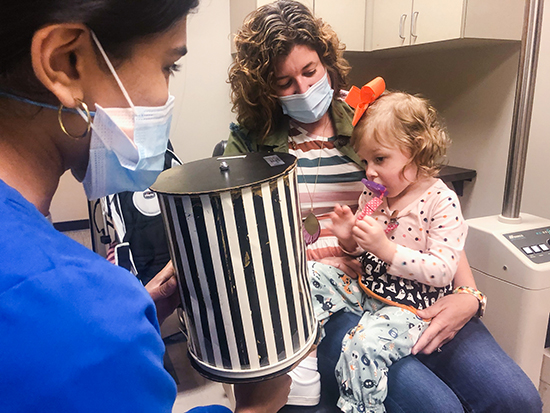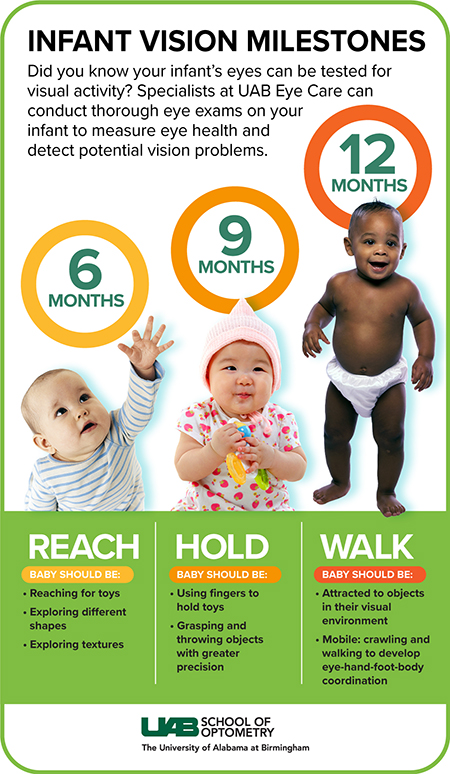Media contact: Brianna Hoge
 Born at 36 weeks, twins Mary and Emily Monk contracted a virus that would lead to one being diagnosed as blind. Twin sisters Mary and Emily are fighters. They were born at 36 weeks and contracted a brain infection caused by parechovirus at 3 weeks old. At 6 months old, their mother, Tara Monk, noticed her babies were not hitting their vision development milestones at the same time.
Born at 36 weeks, twins Mary and Emily Monk contracted a virus that would lead to one being diagnosed as blind. Twin sisters Mary and Emily are fighters. They were born at 36 weeks and contracted a brain infection caused by parechovirus at 3 weeks old. At 6 months old, their mother, Tara Monk, noticed her babies were not hitting their vision development milestones at the same time.
Mary did not follow the spoon when being fed cereal and did not open her mouth until the spoon touched her lips. Emily, on the other hand, watched the spoon and opened her mouth to eat.
Concerned, Monk took her two girls to their pediatrician for an evaluation.
The doctor suggested that Mary may be developing behind her sister and to bring them back for another evaluation at age 9 months. The worried mother remained highly concerned. Not sure what to do next, she spoke with her cousin, a University of Alabama at Birmingham School of Optometry third-year student.
She told her about UAB Eye Care’s InfantSEE program. The program, managed by Optometry Cares®, provides free comprehensive eye exams to children ages 6-12 months. The program is designed to ensure that eye and vision care becomes an essential part of infant wellness care to improve a child’s quality of life.
“A comprehensive eye exam by an experienced pediatric optometrist or ophthalmologist can uncover not only eye problems, but also problems where vision experts can use the eyes as a window to the brain,” said Kathy Weise, O.D., director of Pediatric Optometry Services.
Monk decided to take both girls for an eye exam at UAB Eye Care when they were 8 months old.
During the appointment, Mary’s exam revealed that she could be blind.
“I remember talking to her and using words like ‘visual impairment’ and ‘difficulty seeing,’” Weise said. “I struggled to find the right words.”
Weise understood the impact the diagnosis would have on Mary’s mother and what this prognosis meant for the baby as well as her mother and family.
“I was in total shock. How could my healthy baby not be able to see and potentially be completely blind?” Monk said. “I broke down and started crying. As I looked up, Dr. Weise had tears in her eyes, and I could tell she was concerned about Mary and me. She reassured me that we would find out exactly what was happening with Mary.”
 Weise then referred Mary to neurologist Jayne Ness, M.D., Ph.D., at Children’s of Alabama. An MRI led to Mary’s being diagnosed with cortical visual impairment, due to the parechovirus the babies experienced as newborns.
Weise then referred Mary to neurologist Jayne Ness, M.D., Ph.D., at Children’s of Alabama. An MRI led to Mary’s being diagnosed with cortical visual impairment, due to the parechovirus the babies experienced as newborns.
“This virus is really rare, but is becoming increasingly recognized,” Ness said. “They both contracted the virus, and for reasons we don’t understand, Mary was affected more severely than her twin sister.
“Vision problems are often the first clue that something is going on with a baby’s brain. Vision has early milestones. It’s invaluable to have someone with expertise evaluate the child if milestones are being missed.”
Typical developmental milestones include the following:
- By 6 months of age, an infant should be able to reach for and follow objects or humans, as well as return a smile;
- By 9 months of age, an infant should be able to imitate others using gestures and facial expressions to communicate, grasp small objects with his or her whole hand, and balance well enough to sit upright without support; and
- By 12 months of age, an infant should be able to pick up objects between his or her finger and thumb and be able to begin to explore by crawling, pulling themselves up on objects to stand with support, and walk around furniture.
With Weise’s help, Monk was able to get Mary involved with early intervention, where she receives vision, physical, occupational and speech therapies.
“Our Pediatric Optometry Service is part of an extensive network that includes specialists like Dr. Ness, developmental therapists and other health care providers who work together to improve the well-being of the child,” Weise said. “Our goal is to do whatever we can for our patients to have the best outcomes possible.”
With guidance from the team at UAB Eye Care’s pediatric clinic, Mary has progressed.
“Mary has improved so much since we started therapy,” Monk said. “She can drink from her cup and finger feed some food. We are hopeful that, as Mary grows older, we will continue to see her grow and improve.”